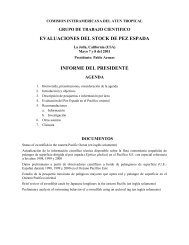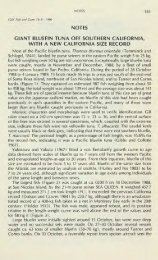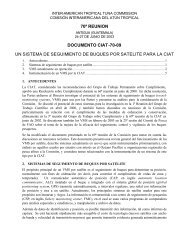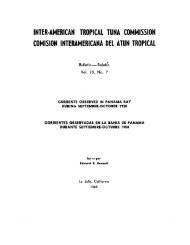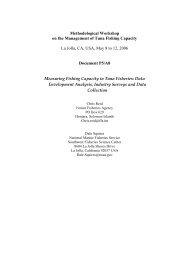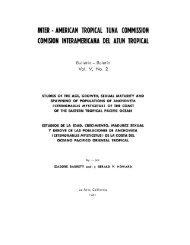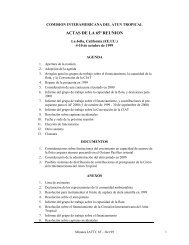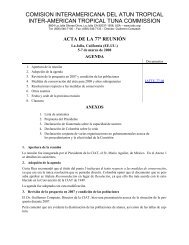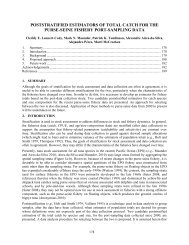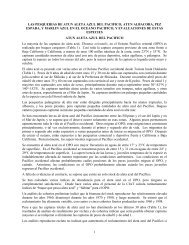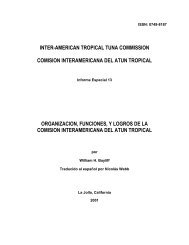Informe Anual de la Comisión Interamericana del Atún Tropical, 19
Informe Anual de la Comisión Interamericana del Atún Tropical, 19
Informe Anual de la Comisión Interamericana del Atún Tropical, 19
Create successful ePaper yourself
Turn your PDF publications into a flip-book with our unique Google optimized e-Paper software.
34 TUNA COMMISSION<br />
Reports ofthe IATTC, only a brief outline is given here, with emphasis on new <strong>de</strong>velopments.<br />
Abundance is estimated from information on sightings and searching effort collected by<br />
IATTC and NMFS scientific technicians aboard tuna vessels. Line transect methodology is used to<br />
obtain abundance estimates from these data. The line transect method, in theory, is straightforward,<br />
but numerous problems are encountered in its application, so the staff must <strong>de</strong>vote consi<strong>de</strong>rable<br />
time and effort to overcoming these problems, to the extent that this is possible. Sorne of the<br />
problems which the staff has had to <strong>de</strong>al with are <strong>de</strong>scribed below.<br />
Because neither the dolphins nor the fishing effort are uniformly distributed in the eastern<br />
Pacific Ocean, it was stratified into geographic regions, each representing approximately the ranges<br />
of the stocks of interest. Within each region, when there are sufficient data, further stratification is<br />
carried out. A smoothed encounter rate is calcu<strong>la</strong>ted for each 1-<strong>de</strong>gree quadrangle, and then<br />
quadrangles with simi<strong>la</strong>r estimates are combined in the same strata. Within each stratum the<br />
distribution of dolphin herds is roughly uniform, thus making it possible to assume random<br />
distribution of herds within the stratum. I<strong>de</strong>ally, further stratification would be carried out, for<br />
example to separate the data by season or fishing mo<strong>de</strong>. For most stocks, however, the data are<br />
insufficient to do this, but it is believed that the most important stratification factors are those<br />
<strong>de</strong>signed to offset the effects ofnon-random searching. Some problems can still arise; for example, if<br />
local concentrations of herds occur and the fishermen are successful in locating these, the <strong>de</strong>nsity<br />
will be overestimated.<br />
Helicopter sightings arise from a very different searching process. The helicopter does not<br />
stay on the trackline ofthe vessel, and if the perpendicu<strong>la</strong>r distances from the trackline of sightings<br />
<strong>de</strong>tected by the helicopter are examined, the shoul<strong>de</strong>r ofthe <strong>de</strong>tection curve is seen to extend many<br />
miles beyond the trackline. These sightings cannot be ignored, since it is not possible to know which<br />
herds would have been <strong>de</strong>tected by the vessel ifthe helicopter had not found them first. Therefore the<br />
helicopter and crew sightings are combined. Conceptually, the helicopter is consi<strong>de</strong>red by this<br />
approach as a mechanism to increase the probability of <strong>de</strong>tection of a herd away from the trackline.<br />
Since the perpendicu<strong>la</strong>r distances are truncated at 5 nautical miles (nm), a distance at which the<br />
target herds are likely to be <strong>de</strong>tected from the vessel in the absence ofa helicopter, the few additional<br />
herds that are <strong>de</strong>tected by the helicopter that would have otherwise have escaped notice will have<br />
little impact on the analyses. Analyses ofthe data tend to confirm this, for although helicopter use<br />
increased from virtually zero in <strong>19</strong>75 to most ofthe fleet in <strong>19</strong>86, it is not possible to <strong>de</strong>tect a trend<br />
over time in the estimates of effective track width.<br />
In poor sighting conditions, lower encounter rates and narrower effective track widths are<br />
expected. Analyses indicate that there is a reduction in encounter rate when data collected during<br />
periods when the wind excee<strong>de</strong>d Beaufort force 3 (7 to 10 knots) are inclu<strong>de</strong>d in the analyses, but no<br />
effect ofwind on the effective track width is discernible. As the <strong>de</strong>nsitywould be un<strong>de</strong>restimated ifall<br />
the data are used, sightings and searching effort data when the wind excee<strong>de</strong>d Beaufort force 3 are<br />
not inclu<strong>de</strong>d in the analyses.<br />
There are periods during most days of a fishing trip when the vessel is searching but the<br />
observer is not on duty, for example during lunch breaks or while he is collecting samples. Because<br />
some sightings ma<strong>de</strong> during these periods are not reported to the technician by the crew, use ofthe<br />
data for these periods would reduce the encounter rate. Accordingly, to prevent negative biases in the<br />
<strong>de</strong>nsity estimates, these data are not used.<br />
If the perpendicu<strong>la</strong>r distance of a herd from the trackline is to be estimated accurately the<br />
observer must accurately record both the sighting distance and the sighting angle before the herd<br />
reacts to the vessel. Unfortunately, the distances and angles are sometimes not recor<strong>de</strong>d until the<br />
vessel has already turned túward the herd, resulting in an average sighting angle for the trip that is<br />
less than expected. Alow average sighting angle suggests that either the herds were not reported to<br />
the technician when first <strong>de</strong>tected or that the technician failed to record accurately the angles and



